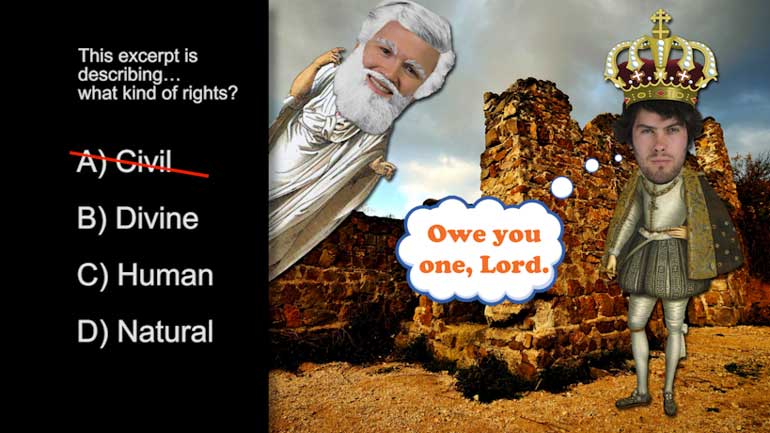ShmoopTube
Where Monty Python meets your 10th grade teacher.
Search Thousands of Shmoop Videos
Modern World History 2.8 Early American Democracy 35 Views
Share It!
Transcript
- 00:04
The revolution is over. Yay.
- 00:07
The British have been banished from the
- 00:08
US of A. Yay. Time for a new nation to set
- 00:12
up a government that actually works. Yay?
- 00:14
Well, contrary to what grandpa might tell
Full Transcript
- 00:17
you at the dinner table, governing a
- 00:19
country is hard work, especially when
- 00:21
you're building a democracy from scratch
- 00:23
and, well Martha Stewart wasn't exactly
- 00:25
around with an easy-to-follow recipe. And
- 00:28
the founding fathers did not get our
- 00:30
government right the first time around...
- 00:31
surprise surprise. They set out to create
- 00:34
a country with the Articles of
- 00:36
Confederation in 1777. Well, this document
- 00:39
was problematic from the beginning.
- 00:41
Because the writers of the Articles were
- 00:42
terrified of having a too-powerful
- 00:45
central government for obvious reasons,
- 00:47
they made the central government of the
- 00:49
new United States too weak. Flimsy,
- 00:52
almost. Well, the American government
- 00:53
couldn't tax its citizens, couldn't raise
- 00:55
an army. There was no president, no
- 00:57
national court, and no national strategy
- 00:59
for combating the restrictive trade
- 01:01
policies put in place by various
- 01:03
European nations. Well that thing was so
- 01:05
weak, you'd think it was on muscle relaxants.
- 01:07
It became clear pretty quickly that the
- 01:09
Articles of Confederation needed a do-
- 01:11
over. The document had been ratified by
- 01:13
all 13 States by 1781, but just six years
- 01:16
later, America's leading brainiacs
- 01:18
were in Philadelphia working on what
- 01:20
would become the US Constitution. Hey,
- 01:23
practice makes perfect, right? There were
- 01:25
some huge differences between the
- 01:27
Articles of Confederation and the
- 01:28
Constitution. First off, the Constitution
- 01:31
called for three branches of government.
- 01:32
Makes for a boring tree but a strong
- 01:35
democracy. There was the Executive branch,
- 01:37
which would soon become home to George
- 01:39
Washington and his wooden teeth, the
- 01:41
Legislative branch, or the Congress, and
- 01:43
the Judicial branch, or the court system... now that's a tree worth hugging. Second,
- 01:48
the Constitution was careful to ensure
- 01:50
that no one branch of the government had
- 01:52
too much power. Enter checks and balances,
- 01:55
which unfortunately had nothing to do
- 01:57
with tightrope walkers paying their
- 01:59
bills. It worked a little more like this:
- 02:01
the Senate and the House of
- 02:02
Representatives may pass a bill that the
- 02:04
judiciary then declares unconstitutional.
- 02:08
Wah, wah. Or, the Senate and the House of
- 02:10
Representatives may pass
- 02:12
a bill that the president then vetoes. Wah, wah. Or,
- 02:15
the legislative branch may in certain
- 02:17
circumstances impeach the president or a
- 02:20
member of the judiciary, and we don't
- 02:22
need to tell you which circumstances
- 02:24
those are. *Cough* Clinton. The idea of a central
- 02:28
authoritative government made many
- 02:29
Americans nervous... very nervous. Some say
- 02:33
that those guys are still nervous today.
- 02:34
They just live in Idaho now. At any rate,
- 02:37
two-thirds of the states needed to say "aye"
- 02:40
in order for the Constitution to be
- 02:42
ratified. Well, the founding fathers knew
- 02:44
that they would need to be persuasive in
- 02:46
order to get the necessary votes. Enter
- 02:49
James Madison, also known as father of
- 02:51
the Constitution and the fourth
- 02:52
president of the United States, and our
- 02:54
personal favorite, J-Mads, yeah. J-Mads
- 02:57
wanted his fellow Americans to
- 02:59
understand that, while the Constitution
- 03:00
would create a stronger central
- 03:02
government than the one that had existed
- 03:04
under the Articles of Confederation, the
- 03:06
individual rights that had been at the
- 03:08
center of the American Revolution would
- 03:10
also be central to the new United States.
- 03:12
Our country was like a tootsie roll pop,
- 03:14
except instead of candy at the center,
- 03:16
it was state liberty. Well, with help of
- 03:18
John Jay, who would become the first
- 03:20
Chief Justice of the United States, and
- 03:23
Alexander Hamilton, who would become the
- 03:25
first secretary of the Treasury and the
- 03:27
subject of a super successful Broadway
- 03:29
musical, well, James Madison produced the
- 03:31
Federalist Papers for publication in New
- 03:34
York's newspapers. While the Federalist
- 03:36
Papers made for a compelling read,
- 03:37
several states, including New York,
- 03:39
Virginia, and Massachusetts, refused to
- 03:42
ratify the Constitution until the
- 03:44
founding fathers agreed to the inclusion
- 03:45
of a bill of rights that would protect
- 03:47
specific individual rights. So you've got
- 03:50
New York and company to thank for your
- 03:52
freedom of speech... no big surprise there.
- 03:54
The Constitution was ratified in 1788,
- 03:57
and when the first US Congress met in
- 03:59
1789, Madison got busy composing the
- 04:02
first ten amendments to the Constitution,
- 04:04
also known as, yes, the Bill of Rights. Not
- 04:06
to be confused with our right-handed
- 04:08
friend, Bill. The American Revolution
- 04:10
ended at Yorktown in 1781. It took
- 04:13
another eight years for America's
- 04:15
political leaders to get a functioning
- 04:17
system of government in place, and well, you know,
- 04:19
next time grandpa tells you that he
- 04:21
could run D.C. from the comfort of his
- 04:23
armchair, perhaps you
- 04:24
should consider breaking out the James
- 04:25
Madison cosplay and giving Gramps a
- 04:28
lesson in American history, which you now
- 04:30
know thanks to us. You're welcome.
Up Next
GED Social Studies 1.1 Civics and Government
Related Videos
When you're about to marry the love of your life, not many things could stop you. However, finding out that your future hubby is keeping his crazy...
Here at Shmoop, we work for kids, not just the bottom line. Founded by David Siminoff and his wife Ellen Siminoff, Shmoop was originally conceived...
ACT Math: Elementary Algebra Drill 4, Problem 5. What is the solution to the problem shown?




